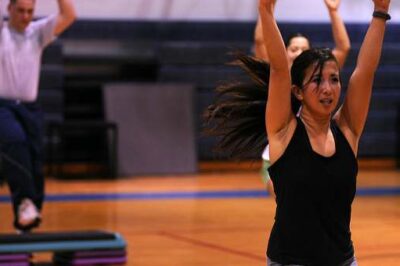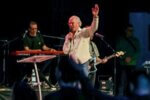Summer is a great time to connect with friends, colleagues, family and church to make a commitment to get outside and enjoy the fresh air, sunshine, company and to praise God while getting fit. Exercising outdoors provides an opportunity to be physically active in a variety of different terrains with sunlight and fresh air. Exercising outdoors is a great way to save money, connect with God and with others and help support others in their devotion to God and health. Whether you join a health club, work out on your own or with a group of friends, getting a group of friends together for a workout has lots of advantages.
Motivation
The No. 1 reason the majority of people either a. don’t exercise at all, b. don’t exercise enough or c. try it for a while and drop out is due to lack of motivation. Thus, getting and staying motivated is often difficult even for seasoned fitness enthusiasts. There is a growing body of scientific evidence to support the improved motivational incentives of group exercise. The majority of people committed to exercising with a group tend to report better adherence, benefits and enjoyment.
“But Jesus looked at them and said, ‘With men this is impossible, but with God all things are possible'” (Matt.19:26).
“But He said to me, ‘My grace is sufficient for you, for My strength is made perfect in weakness.’ Therefore most gladly I will boast in my weaknesses, that the power of Christ may rest upon me” (2 Cor. 12:9).
Accountability
Accountability means to be held accountable, answerable or responsible for what a person has been given. Every believer will be held accountable at Christ’s appearing. A workout group can help you say accountable with your exercise routine. Again, studies confirm that accountability partners improve outcomes in virtually any and all endeavors.
” So then each of us shall give an account of himself to God” (Rom.14:12).
Fellowship
Human beings are social creatures by nature. Working out together is a natural way to enjoy the benefits of friendship, the challenges of getting fit and the pain and struggles that come along with getting in shape. In addition, through fellowship and devotion, it is possible to motivate and inspire others as well as yourself far beyond what you thought possible by yourself.
“We took pleasant counsel together, and walked to the house of God in company” (Ps. 55:14).
Forming a workout group can keep you motivated, hold you accountable and help you develop a sense of fellowship. Group exercise provides us with an opportunity to be physically active with others especially when we don’t always feel like we have the time or opportunities to do so. This offers camaraderie and accountability among and between participants. Most people know exercise is good for them and want to begin exercising. However, they do not know the first step to take. An exercise group can be structured with a purpose to be beneficial for people with limited knowledge about safe and effective exercise programming. A well-designed workout includes warm-up, cool-down and flexibility in addition to the conditioning section. Regardless of your passion or interest, what is most important is to move.
Tips on getting started:
- Use social media such as www.meetup.com
- Connect through local churches and recreation centers.
- Word of mouth
Getting Started Outdoor Fitness Plan
Before you get started, consider who, what and where. Here are some examples of some workouts you can adapt.
Who
Consider who you want to invite to an outdoor fitness group. For example, a walking and stretching group for new moms with kids in strollers would have different goals and objectives than a walking and stretching group for seniors or young adults. So be clear with who is in your group about what the intended goals are. Some groups may be more social, some more high-intensity fitness and some more devotional. A good way to approach the start is to get a group of like-minded people, in both fitness and faith, together and develop an initial plan.
What
These are just a few examples. Be creative and stay focused on the goals and objectives of the group. High-impact sprints up a rugged trail may be great for younger, more fit individuals but not for seniors or moms with strollers and vice versa, of course. Think ahead of time what resources and equipment are necessary.
Devotion:
- Opening prayer
- Check how everyone is doing. What is working and what is not?
- Review plan for the day
- Water, water and water
Warm-up:
- Walking, jogging or running; slow-stretching, light calisthenics
- Slowly speed up movements. Concentrate on whole body warm-up and breathing deeply.
- Arm and leg swings: arm windmill, gently swing one leg forward and back, keeping torso vertical and low back protected.
- Gradually increase range of motion and repetitions.
Workout:
- Start of easy, even five-to-10-minute intervals if necessary, and build up to 30 minutes continuous exercise including walking, cycling or jogging
- Try breaking the workout up into segments, some cardio and some stretching and strength training
- Cross-Training: some cardio time followed by a strength segment, alternating back and forth
Strength: There are so many variations; here are just a few.
- Squats: Find a level patch of ground and start in a deep lunge position.
- Pushups: on grass, on hands and feet or with hands slightly elevated on a deck stair or park bench
- Static or walking lunges
- Triceps extensions: Use a deck, several stairs or a low mounted pull-up bar
Cool Down:
- No matter what type or intensity of exercise, always plan for a cool-down period
- Low-intensity walking, gentle arm and hip swings followed by stretching
- End in prayer
Where
Circuit-type workout, cardiovascular intervals and drills mixed with body weight strength training and can be done on your local playground or beach, with your children or without or even in the privacy of your own backyard.
Next week we will take a look at how to integrate daily devotions and accountability. {eoa}
Scott Roberts, Ph.D., is professor and chair of the Kinesiology Department at William Jessup University.







Leave a Comment
You must be logged in to post a comment.